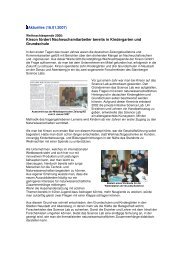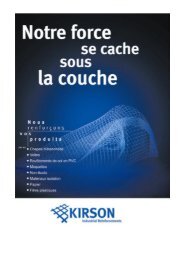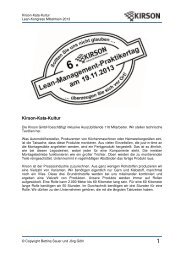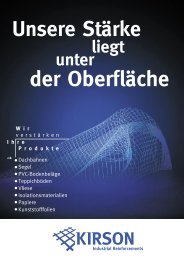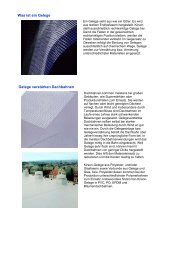Complete Website without News, General Terms and ... - Kirson GmbH
Complete Website without News, General Terms and ... - Kirson GmbH
Complete Website without News, General Terms and ... - Kirson GmbH
- No tags were found...
Create successful ePaper yourself
Turn your PDF publications into a flip-book with our unique Google optimized e-Paper software.
<strong>Kirson</strong> Chronicle1962 Alfons Kirzinger is partner of a weaving mill, the Fategein Neustadt / Donau . He had the idea to build a machinewhich can manufacture open lattice structuressubstantially faster, than the conventional looms can.Alfons KirzingerHorst Kirzinger1963 Father Alfons <strong>and</strong> his son Horst Kirzinger create the <strong>Kirson</strong> patent <strong>and</strong> marketingcompany ltd. (= Kirzinger & son).A factory is established. The company employs three further employees beforethe year end in addition to the two owners.Diagonal scrims are exclusively manufactured with the so-called "impact armmachines".1964 Several parquet manufacturers were won as customers. The personnel grows toten employees. By the 60's <strong>Kirson</strong> scrims are being supplied overseas, e.g. toSouth America.1965 A second production hall is built. The administrative work could no longer bedone alongside the main work. The first employee for theadministration is taken on. The personel grows to twelve employees.Halls 1 <strong>and</strong> 2 (from right to left)1967 The "plastics department" is created. Business purpose is the production of glassfibre reinforced plastic parts, among other things stackable containers, largewaste water containers, feed containers, park benches <strong>and</strong> special parts. Thepersonnel level reaches 21 employees by the end of the year.Preparation of advertising photos for the plastics department at the beginningof the 70's1972 The company founder Alfons Kirzinger dies suddenly <strong>and</strong> unexpectedly. Sales<strong>and</strong> marketing are reorganized.
1973 The fourth production hall is built. Employee numbers reach 30 people, five ofwhich are involved in solely selling <strong>and</strong> administrative activities .1975 Peter August Lückenhaus <strong>GmbH</strong> from Wuppertal takes a 74 per cent share inthe <strong>Kirson</strong> <strong>GmbH</strong>. The manufacturer of lattice fabrics adds to the <strong>Kirson</strong>technology as an important addition to their own delivery programme.1976 The first commercial training takes place.Since this year <strong>Kirson</strong> has regularly trainedcommercial employees. Since 1983also industrial mechanics are trainedregularly.Former trainees, who work today in other companies, in a meeting in the formertraining company in the year 20001980Following declining container sales, the"plastics department" is shut down. <strong>Kirson</strong>concentrates on the production of diagonal <strong>and</strong>rectangular scrims. In November 1980 a largefire almost completely destroys Hall 6.Thanks to the hard work of all employeesin ice cold temperatures production canquickly begin again.The damaged roof of Hall 6 from the fire in 1980.1983 Hall 7 is built.1987 With the building of Hall 7.1 Hall 7 is extended.1991 Halls 8 <strong>and</strong> 8E are built.1993 A new technology considerably improves the manufacture of rectangular scrims. Itwill be possible to manufacture scrims with very evenappearance.The Lückenhaus <strong>GmbH</strong> in Wuppertal is taken over by Mehler AG in Fulda.1997 The participation of Lückenhaus <strong>GmbH</strong> comes to an end in 1997. Mehler AG whohad taken over Lückenhaus some years ago becomes the principal partner of<strong>Kirson</strong>. At the same time Mehler AG is fully integrated into KAP AG, a stockexchange listed company majority owned by the Daun group.
1999 The co founder of the company, Horst Kirzinger <strong>and</strong> his long time managementpartner Reiner Kirch, retire.Horst Kirzinger <strong>and</strong> Reiner Kirch2000 The company is renamed <strong>Kirson</strong> Industrial Reinforcements <strong>GmbH</strong>. With the M 40,another new technology is introduced for the production of scims. The newtechnology differs greatly from the past developments of <strong>Kirson</strong> <strong>and</strong> also from thewell-known procedures of the competitors.2001 With the closure of the M 22 <strong>Kirson</strong> leaves the diagonal technology <strong>and</strong> from nowon concentrates exclusively on the production of rectangular scrims.Diagonal scrim2002 With the building 7.2 greatly improved working conditions are created. The newlyinstalled technology results in much reduced preparation times for the machines.Hall 7.2 after completion in November 20022003 For the first time in the company history the employee numbers reach 90.Thecompletion <strong>and</strong> simultaneous conception of a further production machine enable<strong>Kirson</strong> to meet the increased dem<strong>and</strong> for <strong>Kirson</strong> scrims in the last years.
What is a scrim?A laid scrim looks like a grid or lattice. It ismade from continuous filament products(yarns). <strong>Kirson</strong> produces rectangular scrimsexclusively. In order to keep the yarns in thedesired right-angled position it is necessary tojoin these yarns together. In contrast to wovenproducts the fixation of the warp <strong>and</strong> weftyarns in laid scrims must be done by chemicalbonding. Scrims are used to reinforce manydifferent materials <strong>and</strong> products.Scrims reinforce roofing membranesRoofing or waterproofing membranes aremostly used for large buildings such assupermarkets or production facilities. Theirmain application areas are flat <strong>and</strong> slightlysloped roofs. Roofing membranes are exposedto strongly varying material stress due to windstrength <strong>and</strong> temperature change during theday <strong>and</strong> year. Scrim-reinforced membraneswill almost never break even when exposed tovery strong winds. The membrane will keep itsoriginal shape for years due to its scrimreinforcement. Scrims will mostly form thecentral layer of a three layer laminate. Asscrims tend to be very flat, they allowproduction of roofing membranes which arethinner than similar products reinforced withwoven materials. This helps to reduce the useof raw materials <strong>and</strong> controls the costs of theend-product.<strong>Kirson</strong>-scrims made from polyester- <strong>and</strong>/orglassfibres also <strong>Kirson</strong> scrim laminates madewith glass or polyester-nonwovens are in usefor many different polymer-based membranes.<strong>Kirson</strong> scrims can often be found in roofingmembranes made from PVC, PO, EPDM orbitumen.
Scrims reinforce sailclothFor many years now laminated sails havesubstituted traditional sails made from denselywoven spinnaker cloth. Laminated sails dolook very much like surf sails <strong>and</strong> are oftencomposed of two layers of a transparent filmwhere in between a layer or several layers ofscrims are laminated.As the winds on the open sea can be verystrong, non-reinforced films would soon breakunder this stress, therefore laminated sails arereinforced with scrims made from highperformance fibres. Due to the scrimreinforcement, laminates will last longer thanwoven sails. <strong>Kirson</strong> possesses many years ofexperience in converting aramide, PEN(polyethylene naphthalate), polyester <strong>and</strong> PEyarnsas well as several other high-tech-fibresfor scrims.Scrims reinforce flooring productsFlooring in public buildings such as airports,railway stations or administrative buildings isexposed to a lot of mechanical stress. Not onlylarge numbers of people but many vehiclesincluding fork-lift trucks may use such flooringday in, day out. Good flooring must bear thisdaily stress <strong>without</strong> any loss of performance orquality.The larger the covered surface is, the higherthe dem<strong>and</strong>s will be that the flooring materialshall retain its dimensional stability. Thisimportant requirement can be fulfilled by theuse of scrims or scrim/nonwoven laminatesduring the manufacturing of carpets, PVC orlinoleum-flooring.The use of scrims will often improve theproduction process of the flooringmanufacturer as well <strong>and</strong> thus help to increaseefficiency.
Scrims reinforce nonwovensToday it is almost impossible to imagine aworld <strong>without</strong> nonwovens: nappies,throwaway cloths, filtration media orbuilding materials - many of these may bemade from or under the use of nonwovens.Laid scrims may help to prolong thedurability of nonwoven productsconsiderably by reducing the wear <strong>and</strong> tearof such products through mechanicalstress. Scrims may be laminated during orafter production of a nonwoven. Dependingon the manufacturing process scrims will beplaced between two or more layers of fibres<strong>and</strong> bonded with these in line. Whilst manynonwovens only provide a low stability <strong>and</strong>stiffness of their own, these properties maybe improved considerably by the use ofglass or polyester scrims.Scrims reinforce packaging materialsLarge quantities of scrims are laminatedagainst aluminium foils. The end product -mostly an aluminium-scrim-PE-laminate - isused by producers of glass- <strong>and</strong> rockwoolduring production of their insulation materials.In between two layers of paper, scrims help tomake large envelopes, bags or sacks moretear resistant.Polyester scrims made from very thin yarns,weighing less than 5 g/m² are often used assupport for adhesive tapes. Many of thesetapes can be found in the automotive <strong>and</strong>building sector.Scrims reinforce plastic filmsFilms which are to be used several timeswill often be reinforced with scrims in orderto support strong mechanical stress. Usuallythe scrim will already be integrated duringextrusion or calendering of the film. Thedurability of such reinforced products canoften be multiplied. Typical applications arefilms to cover pools, greenhouses <strong>and</strong> largebuilding sites.
Scrims reinforce many other productsFire-retardant materialsGeo-textilesWallboards made from gypsum or concreteSound insulation materialsFilter elementsAutomotive componentsWiping clothsGlass fibre reinforced plasticsMoulded parts
Typical constructionsSingle warpThis is the most common scrim construction. The firstwarp* thread under a weft** thread is followed by awarp thread above the weft thread. This pattern isrepeated across the whole width. Typically the spacingbetween the threads is regular across the whole width.At the intersections two threads will always meet eachother.* warp = all threads in machine direction** weft = all threads in cross directionDouble warpThe upper <strong>and</strong> lower warp threads will always beplaced one upon the other so that the weft threads willalways be fixed between an upper <strong>and</strong> a lower warpthread. At the intersections three threads will alwaysmeet each other.Scrim nonwoven laminatesA scrim (single or double warp) is laminated onto anonwoven (made from glass, polyester or other fibres).It is possible to produce laminates with nonwovensweighing from 15 to 200 g/m².
Square constructions1/11 warp thread/cm1 weft thread/cm2/22 warp threads/cm2 weft threads/cmOther rectangular constructions3/33 warp threads/cm3 weft threads/cm2/0,52 warp threads/cm0,5 weft threads/cm or 5 weftthreads/dm2/12 warp threads/cm1 weft thread/cmAsymmetrical constructions2/1,52 warp threads/cm1,5 weft threads/cm or 15 weftthreads/dm2/3 4d2 warp threads/cm, each 4thwarp thread doubled3 weft threads/cm2/2 RV2 warp threads/cm, edgesreinforced with 4 instead of 2warp threads/cm2 weft threads/cm2/2 different threads2 warp threads/cm; alternating,e.g. 1 thread polyester, then 1thread glass2 weft threads/cm (polyester orglass)
Advantages of scrims<strong>General</strong>ly laid scrims are about 20 - 40 %thinner than woven products made from thesame yarn <strong>and</strong> with an identical construction.Many European st<strong>and</strong>ards require for roofingmembranes a minimum material coverage onboth sides of the scrim. Laid scrims help toproduce thinner products <strong>without</strong> having toaccept decreased technical values. It ispossible to save more than 20 % of rawmaterials such as PVC or PO.Only scrims permit production of a very thinsymmetrical three layer roofing membrane(1.2 mm) that is often used in Central Europe.Fabrics cannot be used for roofingmembranes that are thinner than 1.5 mm.The structure of a laid scrim is less visible inthe final product than the structure of wovenmaterials. This results in a smoother <strong>and</strong> moreeven surface of the final product.The smoother surface of final productscontaining laid scrims allows to weld or gluelayers of the final products more easily <strong>and</strong>durably with each other.The smoother surfaces will resist soilinglonger <strong>and</strong> more persistently.The use of glassfibre scrim reinforcednonwovens per-mits higher machine speedsfor the production of bitu-men roof sheets.Time <strong>and</strong> labour intensive tears in the bitumenroof sheet plant can therefore be prevented.The mechanical values of bitumen roof sheetsare sub-stantially improved by scrims.Materials that tend to tear easily, such aspaper, foil or films from different plastics, willbe prevented from tearing effectively bylaminating these with laid scrims.Whilst woven products may be suppliedloomstate, a laid scrim will always beimpregnated. Due to this fact <strong>Kirson</strong> has anextensive knowledge in respect to whichbinder may be best suited to differentapplications. The choice of the right adhesivemay enhance the bonding of the laid scrimwith the final product considerably.The fact that the upper <strong>and</strong> lower warp in laidscrims will always be on the same side of theweft yarns guarantees that the warp yarns willalways be under tension. Therefore tensile
powers in warp direction will be absorbedimmediately. Due to this effect, laid scrimsoften show a strongly reduced elongation.When laminating a scrim between two layersof film or other materials, less adhesive will beneeded <strong>and</strong> the cohesion of the laminate willbe improved.The production of scrims always requires athermal drying process. This leads topreshrinking of the polyester <strong>and</strong> otherthermoplastic yarns which will improvesubstantially subsequent treatments done bythe customer.
Technical data raw materialsFibreLinear densityTenacitylb/texTear strength%0.13-0.16PolyestertextileDenier70152PolyesterhightenacityDenier731272555001000150020000.09-0.10Glass Cellulose Aramid PEN Nomextype4502251507536180.12-0.13Denier1822674550.03-0.04Denier38276411451527229030550.36-0.42Denier50010000.17-0.8514-24 17-25 2-5 8-18 3-4 5-9Denier200BindersNonwovensImpregnation Chemical Basis Nonwoven type Weight oz/sq.yd.A Acrylate Glass fibre 0.74 - 5.92EVA Ethylenvinyl acetate Polyester 0.44 - 4.73PUR Polyurethane Cellulose 0.44 - 2.95PVA Polyvinyl alkohol Mixed fibres 0.60 - 2.95PVAcPVCSBPolyvinyl acetatePolyvinyl chlorideStyrol ButadieneTechnical data scrimsConstruction Yarns /inchdenWA/WEtype Tenacity ElongationWA/WE lb /1 %inchWeightoz/sq.yd.RG 5/5 150 PVA 5 150 ca. 23 < 4 0.44RG 7.5/7.5 75PVAcRG 10/10 150PVAcRPES 5/5 1000SBRPES 6.5/6.51000 PVCRG 7.5/7.5 150PVAc on NW 30g7.5 75 ca. 69 < 4 1.4810 150 ca. 46 < 4 1.005 1000 ca. 80 < 24 1.626.5 1000 ca. 103 < 24 2.667.5 150 ca. 46 < 4 1.77Thicknessinchca.0.0098ca.0.0118ca.0.0079ca.0.0118ca.0.0118ca.0.0098
Product make-upWidth 4 up to 133 inchesStripes >4 inches width arepossibleDiametre < 47 inchesReel length
Who is who in ManagementManaging DirectorJörg GöhlTel.: ++49 (0) 9445 / 203-148Fax: ++49 (0) 9445 / 203-593Joerg.Goehl@<strong>Kirson</strong>.deDirector Sales anPurchasingUlrich BauerTel.: ++49 (0) 9445 / 203-136Fax: ++49 (0) 9445 / 203-590Ulrich.Bauer@<strong>Kirson</strong>.deDirector MachineDevelopmentThorsten BüchnerTel.: ++49 (0) 9445 / 203-121Fax: ++49 (0) 9445 / 203-595Thorsten.Buechner@<strong>Kirson</strong>.deAssistant to theManaging DirectorProduct DevelopmentReinhard FerchTel.: ++49 (0) 9445 / 203-122Fax: ++49 (0) 9445 / 203-594Reinhard.Ferch@<strong>Kirson</strong>.de
Who is who in SalesArea Sales ManagerPascale BlanchezTel.: ++49 (0) 9445 / 203-144Fax: ++49 (0) 9445 / 203-590Pascale.Blanchez@<strong>Kirson</strong>.deArea Sales ManagerMaximilian SantlTel.: ++49 (0) 9445 / 203-145Fax: ++49 (0) 9445 / 203-590Maximilian.Santl@<strong>Kirson</strong>.deArea Sales ManagerChristoph LingelbachTel.: ++49 (0) 9445 / 203-140Fax: ++49 (0) 9445 / 203-590Christoph.Lingelbach@<strong>Kirson</strong>.deSales AssistantHelene BlodigTel.: ++49 (0) 9445 / 203-146Fax: ++49 (0) 9445 / 203-590Helene.Blodig@<strong>Kirson</strong>.de
Sales AssistantSonja PirthauerTel.: ++49 (0) 9445 / 203-141Fax: ++49 (0) 9445 / 203-590Sonja.Pirthauer@<strong>Kirson</strong>.deSales AssistantS<strong>and</strong>ra HofmannTel.: ++49 (0) 9445 / 203-142Fax: ++49 (0) 9445 / 203-590S<strong>and</strong>ra.Hofmann@<strong>Kirson</strong>.deR & D / QMQuality AssuranceManagerGerd DossinTel.: ++49 (0) 9445 / 203-150Fax: ++49 (0) 9445 / 203-594Gerd.Dossin@<strong>Kirson</strong>.deQuality AssuranceDaniela LercherTel.: ++49 (0) 9445 / 203-151Fax: ++49 (0) 9445 / 203-594Daniela.Lercher@<strong>Kirson</strong>.de
Binder DevelopmentManagerRaimund LintlTel.: ++49 (0) 9445 / 203-161Fax: ++49 (0) 9445 / 203-594Raimund.Lintl@<strong>Kirson</strong>.deProductionManufacturing ManagerMarkus KirzingerTel.: ++49 (0) 9445 / 203-123Fax: ++49 (0) 9445 / 203-597Markus.Kirzinger@<strong>Kirson</strong>.deOperations ManagerAnton PontaTel.: ++49 (0) 9445 / 203-212Fax: ++49 (0) 9445 / 203-597Anton.Ponta@<strong>Kirson</strong>.de
AgenciesItaliyTIEMME sncdi Tombolato Mario & C.Via Torino 1735018 San Martino di Lupari (PD)Tel.: +39/049/595 24 06Fax: +39/049/595 24 06tombolatomario@tin.ittopSpainMichael Maycock/ Eladio GisbertRexcoC/Maestro Clavé 8, 8a46001 ValenciaTel.: +34/96/352 12 60Fax: +34/96/351 05 57rexco@infonegocio.comtop
Address / Publisher's notesPlace of business :Commercial register :ID turnover tax : DE 128 587 085Address:93333 Neustadt / Donau, MauernHRB-NR. 1112, Registergericht Regensburg<strong>Kirson</strong> Industrial Reinforcements <strong>GmbH</strong>Rossauweg 1493333 Neustadt / DonauGermanyTel.: +49 (0) 9445 / 203 - 0Fax: +49 (0) 9445 / 203 - 590Managing Directors:Our partners:Member of the KAP AGJörg GöhlFried MöllerGrafikstudio Schordieb-i-d Brummer Internet & Designwww.b-i-d.de© Copyright <strong>Kirson</strong> Industrial Reinforcements <strong>GmbH</strong>. All rights reserved.
JobsDue to the fact that all our operations arelocated at our plant in South East Germany,German language skills are a must. Pleaserefer to our Job page in German forinformation about suitable vacancies.Industrial placements for foreign students maysometimes be available in administrativefunctions, sales or finance.In order to protect our knowledge it is our strictpolicy not to offer industrial placements inmanufacturing, research & development,engineering services <strong>and</strong> qualitymanagement.All applications containing a CV, photo <strong>and</strong>copies of testimonials or references shall besent to:<strong>Kirson</strong> <strong>GmbH</strong>Mrs. Helga ScholzRossauweg 1493333 Neustadt/DonauGermany





